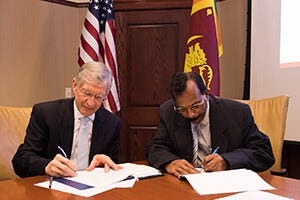ND Receives $2.9 Million To Lead Monsoon Study

Subscriber Benefit
As a subscriber you can listen to articles at work, in the car, or while you work out. Subscribe NowResearchers at the University of Notre Dame have received funding for a five-year monsoon study. The U.S. Office of Naval Research granted the university $2.9 million to measure oceanic and atmospheric conditions and flow patterns of monsoons across the Indian Ocean to help improve predictive models.
"We want to understand fundamental processes that regulate monsoons. The active and break cycles of rainfall within a monsoon season, called monsoon intraseasonal oscillations (MISO), are difficult to predict and involve intricate air-sea dynamics," said Civil and Environmental Engineering and Earth Sciences Endowed Professor Harindra Joseph Fernando.
Fernando, who is also the principal investigator of the study added, "Giant atmospheric wave patterns coming from the Indian Ocean impact countries such as India, Sri Lanka, Singapore and Seychelles, and they circumnavigate and affect global weather – much like we see with the polar vortex. The focus of our research is to look at how these planetary-scale waves shape the regional weather and understand the conditions for extreme rainfall events."
Currently, models can predict monsoon weather seven to 10 days out. Fernando and his research team at Notre Dame hope to improve those predictions to several weeks.
As part of the study, researchers will use a number of sophisticated instruments from research ships, as well as an aircraft, to measure the ocean and atmospheric properties over two monsoon cycles.
Notre Dame joins a number of countries partnering for the study. Most recently, the university signed a five-year memorandum of understanding with the government of Sri Lanka, which will serve as the main hub of the measurement program.
The National Center for Atmospheric Research, National Aquatic Resources Research and Development Agency of Sri Lanka, Maldives Climate Observatory in Hanimaadhoo, Seychelles Meteorological Authority, Army Research Laboratory, Naval Research Laboratory and Charles River Analytics are also participating in the study.
